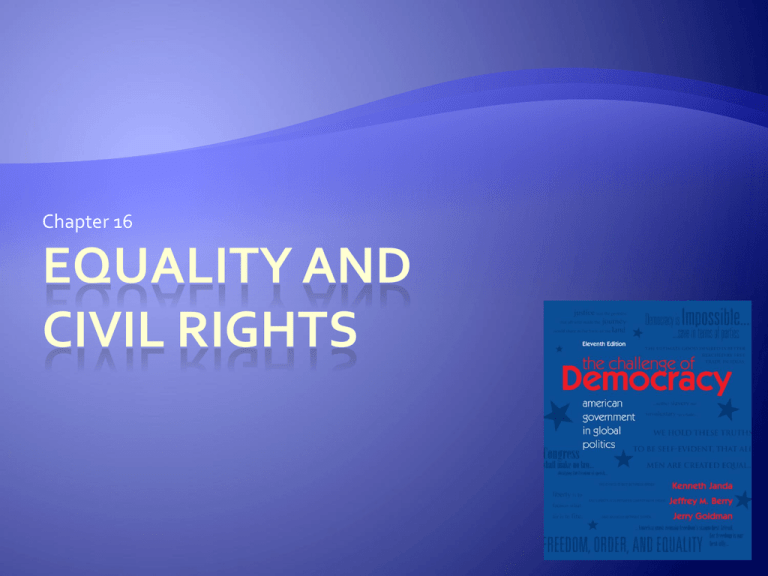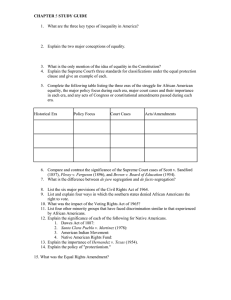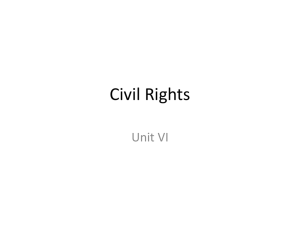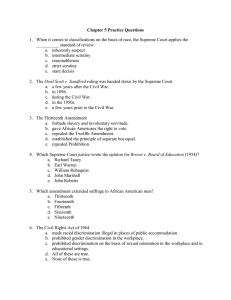Civil Rights
advertisement

Chapter 16 EQUALITY AND CIVIL RIGHTS 2 Two Conceptions of Equality Equality of opportunity: people should have an equal chance to develop talents and rewarded equitably Equality of outcome: greater uniformity in social, economic, and political power among different social groups Invidious discrimination 3 Civil Rights Powers and privileges guaranteed to the individual and protected from arbitrary removal by government or other persons Constitutional amendments and related laws passed to guarantee civil rights after the Civil War Actual rights not a reality until mid-20th century 4 The Civil War Amendments Thirteenth Amendment passed in 1865 Neither slavery nor involuntary servitude… shall exist within the United States, or any place subject to its jurisdiction. Fourteenth Amendment passed in 1869 All persons born or naturalized in the United States, and subject to the jurisdiction thereof, are citizens of the United States and of the State wherein they reside. 5 The Civil War Amendments Fourteenth Amendment also prohibits states from abridging the privileges or immunities of citizens of the United States, or depriving any person of life, liberty, or property, without due process of law. Amendment also guarantees equality: No state shall deny to any person within its jurisdiction the equal protection of the laws. 6 The Civil War Amendments Fifteenth Amendment adopted in 1870 to add political equality: The right of citizens of the United States to vote shall not be denied or abridged by the United States or by any State on account of race, color, or previous condition of servitude. These three amendments granted constitutional equality to blacks Actual equality sometimes thwarted by courts 7 Congress and the Supreme Court: Lawmaking Versus Law Interpreting Congress passed a civil rights act in 1866 to counteract states’ black codes Some provisions in force today Supreme Court rulings weakened or overturned other provisions Several rulings based on idea that states not obligated to honor rights granted by U.S. citizenship 8 Voting Rights Supreme Court ruled Fifteenth Amendment did not guarantee right to vote Some states passed nonracial laws that effectively denied black men voting rights Poll tax Literacy tests Minimum education requirements “Grandfather clause” 9 The Roots of Racial Segregation Well before Civil War, blacks lived separately from whites After the war, southern states passed Jim Crow laws to reinforce segregation Plessy v. Ferguson (1896) upheld stateimposed racial segregation Established separate-but-equal doctrine 10 Separate and Unequal 11 The Dismantling of School Segregation National Association for the Advancement of Colored People (NAACP) founded in 1909 to try other means to access political power First idea pursued: pressing for fully equal facilities for blacks Second area of attack: prove unconstitutionality of segregation 12 Pressure for Equality… Beginning in the 1920s, a few Supreme Court cases offered hope for future changes University of Missouri and University of Texas law schools ordered to admit black students However, separate-but-equal doctrine not revisited 13 …and Pressure for Desegregation President Harry S Truman established the President’s Committee on Civil Rights in 1947 Committee’s report became agenda for civil rights movement Truman also desegregated armed forces The U.S. Department of Justice began submitting briefs in support of civil rights 14 Brown v. Board of Education Began as one case asserting a black child’s right to attend white school close to her home Federal District court ruled black and white school facilities equal and denied request At Supreme Court level, four other cases merged to form class action suit Ruling on first Brown case declared “separate educational facilities are inherently unequal” 15 Anger Erupts in Little Rock 16 Implementation of Brown Ruling Brown v. Board of Education II (1955) ruled schools must desegregate “with all deliberate speed” Some states complied; others did little to desegregate Supreme Court ruled desegregation should happen “at once” in 1969 17 School Integration Several paths to integration approved: Busing Racial quotas Paring or grouping of noncontiguous school zones Swan v. Charlotte-Mecklenburg County Schools said lower courts could order busing These methods only dealt with de jure segregation, not de facto segregation 18 The Civil Rights Movement NAACP’s efforts led to Supreme Court decisions outlawing whites-only primaries and declared segregation on interstate bus routes unconstitutional Dwight D. Eisenhower’s presidency did little to support civil rights Political mobilization of the people became the civil rights movement 19 Civil Disobedience Rosa Parks violated a Montgomery, Alabama law when she sat down in the “whites only” portion of a bus and was arrested when she refused to move Montgomery’s black community called for a boycott of the bus system Martin Luther King, Jr., urged blacks to continue boycott despite harassment Eventually federal court ruled segregated transportation systems unconstitutional 20 Civil Disobedience MLK founded the Southern Christian Leadership Conference (SCLC) Group advocated nonviolent means to bring attention to racial issues Black students sat at whites-only lunch counter Supreme Court upheld actions of demonstrators 21 The Civil Rights Act of 1964 1961: John F. Kennedy became president 1962-1963: President Kennedy took actions to enforce desegregation at universities in the South Also asked Congress for civil rights legislation President Kennedy assassinated November 22, 1963 Lyndon B. Johnson became president Considered civil rights top legislative priority Result was Civil Rights Act of 1964 22 When Leaders Confer 23 The Civil Rights Act of 1964 Entitled all persons to “full and equal enjoyment” with regard to public accommodations Established employment equality rights Strengthened voting rights laws Created Equal Employment Opportunity Commission (EEOC) Federal funds not to be awarded to programs that discriminate 24 The Civil Rights Act of 1964 Supreme Court upheld challenge to law, ruling Congress has ability to regulate interstate commerce First of many rulings broadening federal power based on Commerce Clause 25 President Johnson’s “Great Society” Twenty-fourth Amendment (ratified in 1964) Economic Opportunity Act of 1964 Voting Rights Act of 1965 Fair Housing Act of 1968 26 The Continuing Struggle over Civil Rights Civil rights laws do not ensure compliance Supreme Court’s ruling in Grove City College v. Bell (1984) frustrated enforcement efforts Ruling led to Civil Rights Restoration Act of 1988 Supreme Court’s subsequent rulings limited scope of civil rights laws In one, restricted minority contractor setasides Congress responded with Civil Rights Act of 1991 27 Racial Violence and Black Nationalism Violence on both sides of civil rights movement increased in mid and late 1960s Violence against civil rights workers primarily confined to the South Northern blacks in inner cities rioted, especially after Martin Luther King’s assassination in 1968 Lack of progress towards equality led to black nationalist movement, with some positive results Malcolm X leading voice of Nation of Islam until assassination in 1965 Stokely Carmichael, chair of Student Nonviolent Coordinating Committee, called for “black power” 28 Civil Rights for Other Minorities Recent court decisions and civil rights laws expand protections to all minorities 1987 Supreme Court decision expanded interpretation of Civil Rights Act of 1866 Covers discrimination related to jobs, rental housing, and other prohibited discrimination 29 Native Americans Government relations with native Indians in 18th and 19th centuries denied political and social rights Broken promises sometimes led to violence Early 20th century policies promoted assimilation Indians received citizenship in 1924 Native land holdings continued to shrink 30 Native Americans Frustration with U.S. policies led to militant action in late 1960s and early 1970s Seizure of Alcatraz Island Hostages at Wounded Knee, South Dakota Some land returned in 1970s Some awards by Supreme Court Establishment of casinos on reservations 31 Immigrant Groups Statue of Liberty icon symbolizing U.S. as nation of immigrants However, until 1965, immigration laws discriminatory Quota systems 1965 law designed to reunite families, leading to “chain migration” Did not address illegal immigration 32 Illegal Immigration Demand for cheap labor drives illegal immigration 1986 law set fines for hiring illegal immigrants Also offered amnesty to resident illegal immigrants Lax enforcement and fake “green cards” doomed law’s strategies 33 Figure 16.1 Illegal Immigrants in the United States, 2009 34 Illegal Immigration By 2006, over 11 million illegal immigrants lived in U.S.; politicians called for immigration reform Burden on public services Threat to national security But, do pay Social Security with no return Immigrant organizers sponsored non-violent demonstration opposing some proposals 35 Strolling Protest 36 Illegal Immigration Illegal immigrants easy targets for those frustrated by economic downturns Arizona passed the Support Our Law Enforcement and Safe Neighborhoods Act in 2010, the strictest in nation State crime to be illegal immigrant Aliens must carry documentation Police to determine immigration status Steps up enforcement Penalties for helping or hiring illegal immigrants 37 Latinos and Hispanics Many immigrated to Southwest to work in agriculture Most faced poverty and discrimination Many left country during Great Depression, but numbers in U.S. increased again during WWII Minority farm workers in California lived in poverty, as did workers in cities 38 Latinos and Hispanics Cesar Chavez led United Farm Workers union in strike against growers in 1965 Wanted better pay, working conditions, and housing for farm workers In 1970s and 1980s, immigration from countries other than Mexico and Puerto Rico increased Discrimination compounded by population’s difficulties learning and using a new language 39 Latinos and Hispanics Language barriers result in lower voter registration and turnout for Hispanics Nine majority-minority districts created to increase representation Under scrutiny by Supreme Court Recent years have seen growing Hispanic political power More elected officials at all levels of government Appointment of Sonia Sotomayor to Supreme Court 40 Americans with Disabilities After over 20 years of struggle, Americans with Disabilities Act (ADA) passed in 1990 Extents protections of Civil Rights Act of 1964 to many categories of disabilities Question of “what is the meaning of disability?” complex Original definition vague 41 Homosexual Americans Police raid of Stonewall Inn in 1969 and subsequent riots sparked gay liberation movement National Gay and Lesbian Task Force (NGLTF) lobbied for gays to serve in public employment Founded Legislative Lawyering Program Human Rights Campaign founded in 1980 42 Homosexual Americans Significant progress made since 1970s Two homosexual members of 110th Congress But still do not enjoy all laws protecting other minority groups Military’s “don’t ask, don’t tell” policy established by Clinton administration remains controversial Domestic partner benefits not uniform 43 Homosexual Americans Same-sex marriages another issue Massachusetts Supreme Court ruled same-sex couples could marry in 2003 At least 37 states prohibit same-sex marriages California battle regarding same-sex marriage began in 2000 Supreme Court’s decision in Boy Scouts of America v. Dale (2000) highlights conflict between freedom and equality 44 Gender and Equal Rights: The Women’s Movement Women’s movement a fight against protectionism Demand for women’s rights began with abolition movement Courts consistently upheld protectionist laws Supreme Court 1991 ruling struck down a company’s fetal protection policy as discriminatory 45 Political Equality for Women Women’s suffrage movement began in late 1800s Susan B. Anthony convinced a senator to introduce constitutional amendment supporting voting rights for women in 1878 Police arrested 218 women picketing the White House, demanding right to vote Nineteenth Amendment passed in 1920 46 Political Equality for Women Even after passage of Nineteenth Amendment, protectionist employment attitudes and policies continued Fewer educational opportunities Fewer employment opportunities Lower wages 47 Gender Quotas for Representatives in Lower Legislative Houses Several countries mandate quotas for election of women to public office Some written into constitutions; others are statutes or even quotas set by political parties Some are quotas for candidates; others are quotas for those actually elected Mixed results Quotas most effective in proportional representation systems 48 Politics in a Changing World 49 Politics in a Changing World 50 Prohibiting Sex-Based Discrimination Equal Pay Act of 1963 advanced pay equality but did not overturn other protectionist state laws Civil Rights Act of 1964 also prohibited sexism Title IX of the Education Amendments of 1972 prohibited sex discrimination in federally aided education programs Revenue Act of 1972 established child care tax credits Lilly Ledbetter Fair Pay Act of 2009 a response to 2007 Supreme Court ruling regarding pay discrimination 51 Obama Signs Equal-Pay Legislation 52 Stereotypes Under Scrutiny Beginning in early 1970s, Supreme Court began ruling against gender-based protectionism In 1976, Court established standard: gender-based distinctions justifiable only if they serve some important government purpose However, courts reluctant to address concept of comparable worth 53 Stereotypes Under Scrutiny Courts do support applying constitutional guarantees won by blacks to women No discrimination in jury selection The Virginia Military Institution’s (VMI) men-only admissions policies overturned in United States v. Virginia Distinctions based on sex almost as suspect as discriminations based on race 54 The Equal Rights Amendment The Supreme Court has not extended the protections of the Fourteenth Amendment beyond issues of race An equal rights amendment (ERA) was introduced in 1923 Finally approved by Congress in 1972 The ERA died in 1982, three states short of adoption 55 Why did the ERA fail? Proponents made national campaign; opponents, a state-based campaign Proponents exaggerated effects; opponents capitalized on fears of those effects Despite ERA’s failure, ratification movement provided many benefits for women 56 Affirmative Action: Equal Opportunity or Equal Outcome? Affirmative action programs designed to overcome effects of present and past discrimination Goal is to move beyond equality of opportunity to equality of outcome Numerical or percentage goals most aggressive form Also includes increased recruitment efforts 57 Affirmative Action Proponents believe quotas provide opportunities to groups so discriminated against that they can’t take advantage of equal opportunities Seldom explicitly legislated Government-mandated policies began in 1965 with Office of Federal Contract Compliance Opponents believe quota programs can lead to reverse discrimination or benefits to lessqualified applicants 58 How Others Struggle with Affirmative Action India has “positive discrimination” policies, which have resulted in increased tensions between upper and lower castes Brazil’s racial quotas difficult to apply because 42 percent of population racially mixed Critics claim South Africa’s policies benefit only senior members of the ruling African National Congress Majoritarian and pluralist models approach solutions differently 59 Reverse Discrimination Supreme Court decision in Regents of the University of California v. Bakke said race could only be “plus” factor for admissions Groups opposed to affirmative action took other situations to court, with mixed results Gratz v. Bollinger Grutter v. Bollinger Community Schools v. Seattle School District No. 1 60 Affirmative Action Arena 61 The Politics of Affirmative Action Survey results not surprising: blacks favor affirmative action and whites do not So, how do we account for persistence of equal outcome policies? Politicians want votes, so expand number of protected groups and benefits provided Many Americans view programs as a violation of personal freedoms 62




